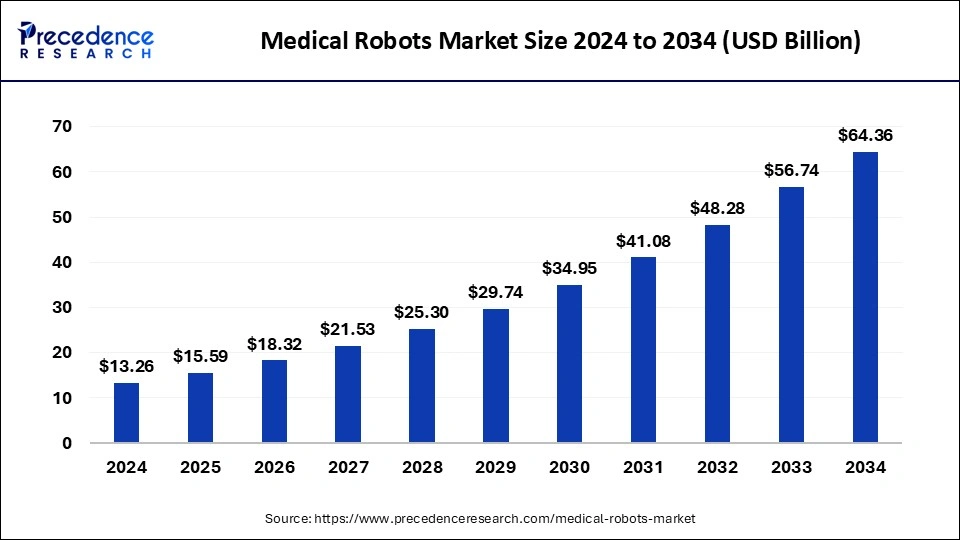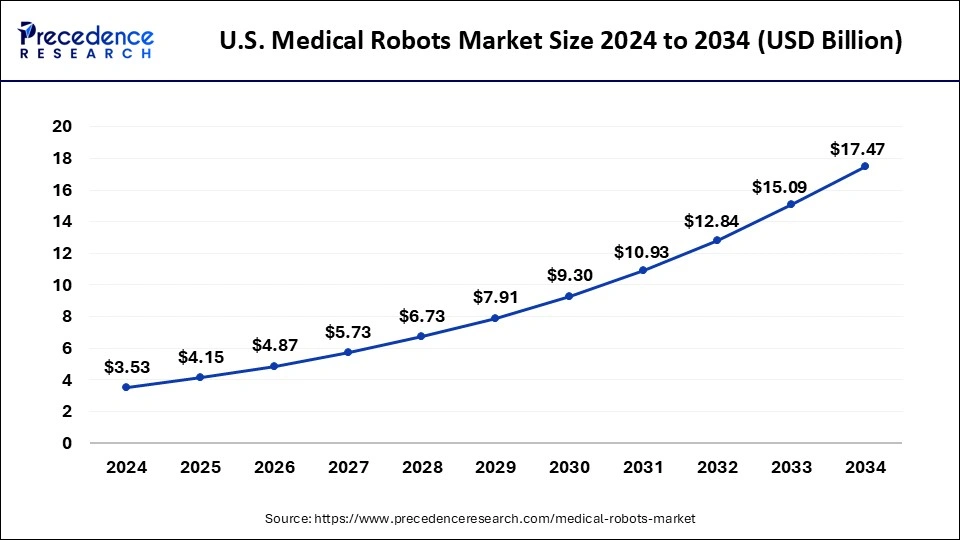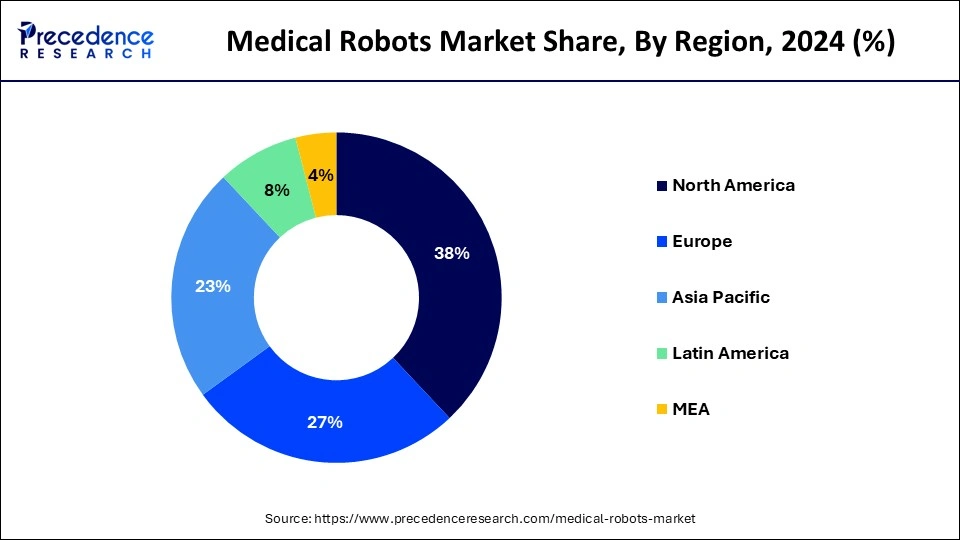List of Contents
Medical Robots Market Size and Forecast 2025 to 2034
The global medical robots market size was estimated at USD 13.26 billion in 2024 and is predicted to increase from USD 15.59 billion in 2025 to approximately USD 64.36 billion by 2034, expanding at a CAGR of 17.11% from 2025 to 2034. Medical robots are helpful for minimizing invasive procedures, improving workplace safety, and frequent and personalized monitoring for patients who suffer from the prevalence of chronic diseases.

Medical Robots Market Key Takeaways
- In terms of revenue, the medical robots market is valued at 15.59 billion in 2025.
- It is projected to reach 64.36 billion by 2034.
- The market is expected to grow at a CAGR of 17.11% from 2025 to 2034.
- North America dominated the market with the largest revenue share of 38% in 2024.
- By product type, the surgical robots segment has contributed more than 64% of revenue share of in 2024.
- By product type, the pharmacy and hospital automation robots segment is estimated to be the fastest-growing during the forecast period.
- By application type, the laparoscopic application segment has held a major revenue share of 36% in 2024.
- By end-use type, the hospitals segment has generated more than 67% of revenue share in 2024.
U.S. Medical Robots Market Size and Growth 2025 to 2034
The U.S. medical robots market size was estimated at USD 3.53 billion in 2024 and is predicted to be worth around USD 17.47 billion by 2034 with a CAGR of 17.34% from 2025 to 2034.

North America dominated the medical robots market in 2024. The U.S. is the leading country for the growth of the market in the North American region. In the United States, there are many top surgical robot companies. The U.S. companies highly invest in robots. Apart from top companies, the region has technological advancements and government support, which adds up to advanced infrastructure and better facilities.
- In April 2025, Myomo, Inc., a wearable medical robotics company, announced the launch of the MyoPro 2x, the latest evolution in its flagship MyoPro product line. Designed to enhance the user experience, the MyoPro 2x introduces a reimagined approach to donning, empowering users with a more intuitive, efficient, and consistent process.
- In September 2023, the launch of the new Candy Robotic AI Surgical System was announced by the Jerome Canady Research Institute for Advanced and Technological Sciences (JCRI-ABTS) and the United States Medical Innovations (USMI). The new system offers 3D navigational guided surgical planning and AI-powered software programs.
- In May 2024, a South Korean developer of 3D optical inspection devices, Koh Young Technology Inc., aims to launch a brain surgery robot in the U.S. in 2025 to make inroads into the world's largest medical robots market.

Europe also had a Increasing funding for medical robot research, increasing use of robot-assisted rehabilitation therapy, advanced technologies of medical robots, and increasing senior population are the main drivers of the growth of the medical robots market. Computer power,artificial intelligence, and miniaturization contribute to the use of medical robots for medicines. France is the leading country in the growth of the European market.
- In September 2022, a spine surgery platform was developed by a company specializing in surgical robotics, eCential Robotics, based in Grenoble, France, and approved by the Food and Drug Administration (FDA). It provides intra-operative 3D and 2D imaging, robotic, and navigation guidance to perform surgical procedures.
- In December 2023, Bavaria, a Germany-based robotics firm German Bionic, announced that they had secured €15M in an extension Series A round of funding. This firm manufactures and develops wearable technologies and smart power suits and the fund helps to develop an AI-powered robotic endoskeleton for workplace safety.
- In April 2024, a medical robotics company, Quantum Surgical, Montpellier, France, announced that it had secured €30M loan from the EIB (European Investment Bank). This funding helped the French Company advance the commercialization of a medical robot named Epione, which is designed for the minimally invasive treatment of lung and abdominal cancer.
Market Overview
The medical robots market is the industry that focuses on the development, manufacturing, and use of robotic systems and technologies in healthcare. These medical robot devices are intended to help and enhance treatments, medical operations, and diagnoses. These medical robots help provide more affordable and safer medical procedures and help minimize invasive procedures. Medical robots help relieve medical personnel from boring routine tasks. It helps to assist with surgery and improve workplace safety. It helps to decrease the workload of the health staff.
It helps in the social engagement of elderly people and intelligent therapeutics. Medical robots are helpful for the frequent and personalized monitoring of patients with the prevalence of chronic diseases. It provides a safe work environment for healthcare workers and patients, effective processes in streamlined clinical workflows, and high-quality patient care. These benefits help to the growth of the market.
- According to the International Federation of Robotics (IFR), the sales of medical robots increased by 36% to around 6,100 units in 2023. Sales of rehabilitation and non-invasive therapy robots were up 128%. Demand for surgery robots rose by 14%, and sales of robots for diagnostics increased by 25%.
Medical Robots Market Growth Factors
- The benefits of medical robots include not wasting time, flawless performance, and proper monitoring services of the patients.
- Many types of medical robots are used in the healthcare sector, including social robots, hospital robots, robotic prosthetics, laboratory robots, rehabilitation robots, radiotherapy robots, surgical robots, etc.
- Medical robots help to reduce the risks of infections in hospitals and minimize the necessity of human contact with patients.
- With its automated and precise movements, it can perform the procedures with minimum invasiveness by reducing the risks of infection transmission.
- The success rate of surgeries is higher with the help of medical robots. Medical robots' benefits include a safe work environment for healthcare workers and patients, an effective process of streamlined clinical workflows, and a high level of patient care.
- The surgeries carried out with the help of medical robots have major advantages in that they are without errors and smoother. These factors help the growth of the medical robots market.
Market Scope
| Report Coverage | Details |
| Market Size in 2025 | USD 15.59 Billion |
| Market Size by 2034 | USD 64.36 Billion |
| Growth Rate from 2025 to 2034 | CAGR of 17.11% |
| Largest Market | North America |
| Base Year | 2024 |
| Forecast Period | 2025 to 2034 |
| Segments Covered | Product Type, Application Type, End-use Type, and Regions |
| Regions Covered | North America, Europe, Asia-Pacific, Latin America, and Middle East & Africa |
Market Dynamics
Drivers
Rising necessity to minimize medication errors
Medical robots are highly used to minimize medication errors. By improving the precision of surgical techniques and performing procedures with minimal invasiveness, medical robots accelerate recovery times and enhance surgical outcomes. Medical robots are helpful to perform tasks with accuracy and precision and they help to minimize the risk of human error during the procedures. These medical robots help to shorten the recovery periods and lower the risk of complications. These factors help the growth of the medical robots market.
Rising use in the healthcare industry
There are many beneficial reasons to use medical robots in the healthcare industry. Medical robots are enough to assist surgeons during the surgical process. These are helpful for performing surgical operations without errors. It helps to enhance the success rates of surgical operations. Medical robots are highly used to improve workplace safety. Medical robots are helpful in systematic and controlled cleaning, which can help reduce the circulation of pathogens and prevent healthcare professionals from getting infected. In the healthcare sector, the use of medical robots decreases the workload of the health staff. These factors help the growth of the medical robots market.
According to the data published by the International Federation of Robotics (IFR), the top three countries of service and medical robot suppliers:
- The United States is home to the largest number of service and medical robot manufacturers in the world, with the presence of 199 companies headquartered. Manufacturers produce 12% of medical robots.
- China ranks second with a total of 107 service and medical robot manufacturers, offering 5% medical robots.
- Germany ranks third with 83 companies. A total of 12% offering medical robots.
- From a regional perspective, the majority of service and medical robot manufacturers are based in Europe with a global market share of 44%, Asia with 29% and the Americas with 25%.
Restraint
Challenges of the medical robots
Challenges of the medical robots in the healthcare sector include safety risks, lack of skilled professionals, and lack of patient trust. There are some chances of failures and errors, and a single mechanical fault may cost human lives. In the surgical robots case, a small risk of bleeding and infections can not neglected. There are several disadvantages of medical robots, including cost, which leads to less use of medical robots in advanced hospitals, developed countries, and research centers. In the healthcare sector, medical robots may replace the health staff, leading to unemployment. These disadvantages may restrict the growth of the medical robots market.
Opportunity
Advanced technologies use
Implementation of advanced technologies in medical robots will help to grow the medical robots market. The use of AI (Artificial Intelligence) allowed data analytics and computer vision to transform medical robots. This helps to expand their capabilities into the many other healthcare sectors. Investment in the research and development for the development of medical robots, including autonomous and modular mobile robots and surgical assistance. The use of automation robots is helpful in the pharmacy and hospital sectors. These advanced technologies minimize the risk of human errors and help automatically label and package medications. These factors help to the growth of the market.
Product Type Insights
The surgical robots segment dominated the medical robots market in 2024. The surgical robots offer many benefits, including minimum scaring, help to reduce transfusion, post-surgery pains, and blood loss, reduced risk of infections, smaller and fever scars, rapid recovery time, and back to normal activities, reduced discomfort and pain, and shorter hospitalization stays. For surgeons, the use of surgical robots has major advantages, including greater precision, improved dexterity, elimination of the surgeon's hand tremor, less tiredness for the surgeons, and greater visualization because of the magnification of the camera.
The surgical robots have many applications based on their benefits, including wristed articulation, improved 3-dimensional visualization, superior tissue handling and instrument dexterity, and enhanced surgeon autonomy and control. These factors help the growth of the surgical robots product type segment and contribute to the growth of the market.
The pharmacy and hospital automation robots segment is the fastest-growing during the forecast period. The use of pharmacy and hospital automation robots has many advantages, including evidence-based care, improved clinical decision support systems, effective inventory management for reduced waste and stockouts, real-time patient vitals monitoring and response to the medication therapy, improved patient medication history management, and medication reconciliation, and improved medication safety through the error prevention and error identification.
Pharmacy automation robots are helpful in automatically labeling and packaging medications, and they reduce potential errors and manual labor errors. These are helpful for pharmacists' empowerment, improving patient safety, improving efficiency by increasing the speed of the service and reducing the waiting time of the patient. Automation robots minimize the risk of human errors in prescription filling and medication dispensing, which leads to accurate drug administration. These factors help the growth of the pharmacy and hospital automation robots type segment and contribute to the growth of the medical robots market.
Application Type Insights
The laparoscopic application type segment dominated the market in 2024. Medical robots are highly used in laparoscopic surgeries. This is because it works for many purposes, including providing training, assisting surgeons with precise movements, and holding laparoscopes. Surgical robots or medical robots are used in the laparoscopic application. Robotic-assisted laparoscopic surgeries can be a challenge to transform the performance with minimum invasive surgery. These factors help the growth of the laparoscopic application type segment and contribute to the growth of the medical robots market.
End-use Type Insights
The hospital end-user type segment dominated the medical robots market in 2024. Medical robots are highly used in the hospital sector to support the minimum invasive procedures and frequent and customized monitoring for patients who suffer from chronic diseases. Medical robots provide more affordable and safer medical procedures, assist with surgery, improve workplace safety, and help with minimally invasive procedures. Frequent and personalized monitoring for patients with a prevalence of chronic disease. These factors helped the growth of the hospital end-user type segment and contributed to the growth of the market.
Medical Robots Market Companies
- Aethon
- ARXIUM
- ACCURACY
- Capsa Healthcare
- Hocoma AG
- Intuitive Surgical, Inc.
- Johnson & Johnson
- Medtronic Plc
- Renishaw plc
- Omnicell Inc.
- Stryker Corporation
- Smith & Nephew plc
- THINK Surgical, Inc.
- Zimmer Biomet
Recent Developments
- In July 2024, Saudi Arabia's King Faisal Specialist Hospital & Research Centre (KFSH&RC) reported a 98% survival rate for 400 robotic cardiac surgeries performed at the hospital, since programme initiation in February 2019. The hospital reported that the use of robotics improved patient outcomes, compared to traditional surgical methods. Robotic surgeries reduced blood transfusions and mechanical ventilation time.
- In January 2025, Prashanth Hospitals launched the surgical robotic system for minimally invasive surgeries. The robotic surgery focuses on offering early recovery, less pain, less blood loss, and reduced incisions, and added that the hospital launched an indigenously developed robot. The system is equipped with four robotic arms, an open design surgical console, imaging and illumination equipment, and a wide range of robotic instruments.
- In March 2025, NVIDIA announced a collaboration with GE HealthCare to advance innovation in autonomous imaging, focused on developing autonomous X-ray technologies and ultrasound applications. Building autonomy into systems like X-ray and ultrasound requires medical imaging systems to understand and operate in the physical world.
- In March 2023, a new robotic surgical trial system, the “Robotic Bronchoscopy Trial,” was launched in Australia.
- In August 2023, the CK Birla Hospital partnered with Intuitive India to launch da Vinci, a surgical robot for advanced medical treatment. It provides patient-centric, ethical, and compassionate healthcare.
- In October 2023, the Saudi Research Center and Saudi Arabia's King Faisal Specialist Hospital launched a humanoid robot employee, “Nour R1,” to assist both visitors and staff and elevate healthcare in the Kingdom.
- In March 2024, HCA Healthcare's London Bridge Hospital, the first healthcare provider in the UK, launched a Transformative robotic-assisted surgery using the da Vinci Single Port System.
Segments Covered in the Report
By Product Type
- Surgical Robots
- Telemedicine Robots
- Rehabilitation Robots
- Noninvasive Radio Surgery Robots
- Pharmacy and Hospital Automation Robots
By Application Type
- Neurology Applications
- Cardiology Applications
- Orthopedic Applications
- Laparoscopic Applications
- Pharmacy applications
- Physical Rehabilitation
- Others
By End-use Type
- Hospitals
- Rehabilitation Centers
- Ambulatory Surgical Centers (ASCs)
- Others
By Geography
- North America
- Asia Pacific
- Europe
- Latin America
- Middle East & Africa
For inquiries regarding discounts, bulk purchases, or customization requests, please contact us at sales@precedenceresearch.com
Frequently Asked Questions
Ask For Sample
No cookie-cutter, only authentic analysis – take the 1st step to become a Precedence Research client